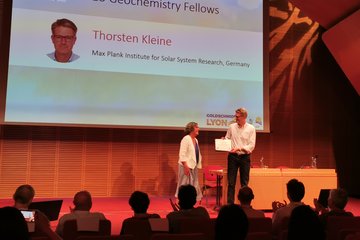Alle Typen
181.
Zeitschriftenartikel
Partial reflection results in the auroral D-region explained in terms of acoustic waves. Journal of Atmospheric and Terrestrial Physics 42, S. 809 - 814 (1980)
182.
Zeitschriftenartikel
Some characteristics of the quiet polar D-region and mesosphere obtained with the partial reflection method. Journal of Atmospheric and Terrestrial Physics 40, S. 205 - 213 (1978)
183.
Zeitschriftenartikel
Amplitudenverhalten partieller Echos in der ruhigen polaren D-Region. Space Science Reviews 20, S. 257 - 265 (1977)
184.
Zeitschriftenartikel
Interplanetary magnetic field polarity changes and D-region radio waves absorption. Journal of Atmospheric and Terrestrial Physics 39, S. 101 - 103 (1977)
185.
Zeitschriftenartikel
A partial reflection experiment using the FM-CW technique. Radio Science 11, S. 1009 - 1018 (1976)
186.
Zeitschriftenartikel
Measured and calculated secondary electron energy spectra (20-1500 eV) above 120 km. Journal Geophysical Research 41, S. 215 - 218 (1975)
187.
Zeitschriftenartikel
Messung niederenergetischer Elektronen (20-1350 eV) in der äquatorialen und polaren Ionosphäre - Vorläufige Ergebnisse. Kleinheubacher Berichte 17, S. 229 - 235 (1974)
188.
Zeitschriftenartikel
Monte Carlo simulation of a model ionosphere - III. Photoelectron and escape electron spectra. Journal of Atmospheric and Terrestrial Physics 36, S. 183 - 187 (1974)
189.
Zeitschriftenartikel
Monte Carlo simulation of a model ionosphere - II. Energy flow and energy dissipation. Journal of Atmospheric and Terrestrial Physics 35, S. 415 - 424 (1973)
190.
Zeitschriftenartikel
Partial reflection measurements with FM-CW - A preliminary investigation. Zeitschrift für Geophysik 38, S. 953 - 957 (1972)
191.
Zeitschriftenartikel
Elektronendichteprofile in der gestörten D-Schicht beim Einfall energiereicher Teilchen. Kleinheubacher Berichte 15, S. 143 - 149 (1972)
192.
Zeitschriftenartikel
Über die Anwendbarkeit des FM-CW Verfahrens bei der Methode der partiellen Reflexionen. Kleinheubacher Berichte 16, S. 255 - 263 (1972)
193.
Zeitschriftenartikel
Photoionization yields of O, O2 and N2 for high and low solar activity. Journal of Atmospheric and Terrestrial Physics 33, S. 1923 - 1931 (1971)
194.
Zeitschriftenartikel
Note on multiple-core structure of the hadronic component of extensive air showers. Canadian Journal of Physics 46, S. 37 - 40 (1968)
195.
Zeitschriftenartikel
Monte-Carlo studies on electromagnetic cascades in extensive air showers. Can. Journ. Phys. 46, S. 189 - 196 (1968)
196.
Zeitschriftenartikel
Direct penetration of the polar electric field to the equator during a DP 2 event as detected by the auroral and equatorial magnetometer chains and the EISCAT radar. Journal Geophysical Research 101, S. 17161 - 17173 (1966)
197.
Zeitschriftenartikel
Coherent backscatter from ionospheric E-region plasma irregularities. Journal of Atmospheric and Terrestrial Physics 58, S. 933 - 941 (1966)
198.
Buch
Modern Ionospheric Science. A Collection of Articles Published on the Occasion of the Anniversary: ``50 Years of Ionospheric Research in Lindau''. European Geophysical Society, Katlenburg-Lindau (1996), 551 S.
199.
Buch
Vom Regenbogen zum Polarlicht. Spektrum Verlag, Heidelberg (1995)
200.
Buchkapitel
Das Institut und die URSI. In: 60 Jahre Forschung in Lindau, 1946-2006, S. 87 - 90 (Hg. Czechowsky, P.; Rüster, R.). Copernicus Publications (2007)











